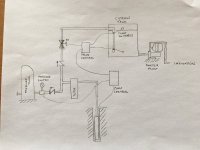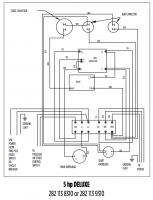Mannekino
New Member
I have a deep well with a 5hp pump feeding both our main house as well as multiple irrigation lines. The well pump is controlled via an 86 gallon pressure tank and during some irrigation days in the summer, this setup can kick on the well pump up to 100 times in a day, which we want to change.
So, we’re looking at placing an 1,800 gallon underground cistern up on the hill behind the house. The well pump would then feed the cistern with some float control switches and a 3/4hp cistern pump would feed the house and the irrigation lines via the same pressure tank.
Now, my wife is not fond of the potential of a mild plastic taste of our otherwise super-clean well water. We are lucky to have exceptional water quality. So, I am curious whether anybody can give insight into the potential of a cost-effective control setup where the well pump can feed the pressure tank in the main house separate from the cistern. The latter would then only be plumbing to feed the irrigation lines via a 3/4hp cistern pump and a constant pressure controller.
Thanks much.
So, we’re looking at placing an 1,800 gallon underground cistern up on the hill behind the house. The well pump would then feed the cistern with some float control switches and a 3/4hp cistern pump would feed the house and the irrigation lines via the same pressure tank.
Now, my wife is not fond of the potential of a mild plastic taste of our otherwise super-clean well water. We are lucky to have exceptional water quality. So, I am curious whether anybody can give insight into the potential of a cost-effective control setup where the well pump can feed the pressure tank in the main house separate from the cistern. The latter would then only be plumbing to feed the irrigation lines via a 3/4hp cistern pump and a constant pressure controller.
Thanks much.


